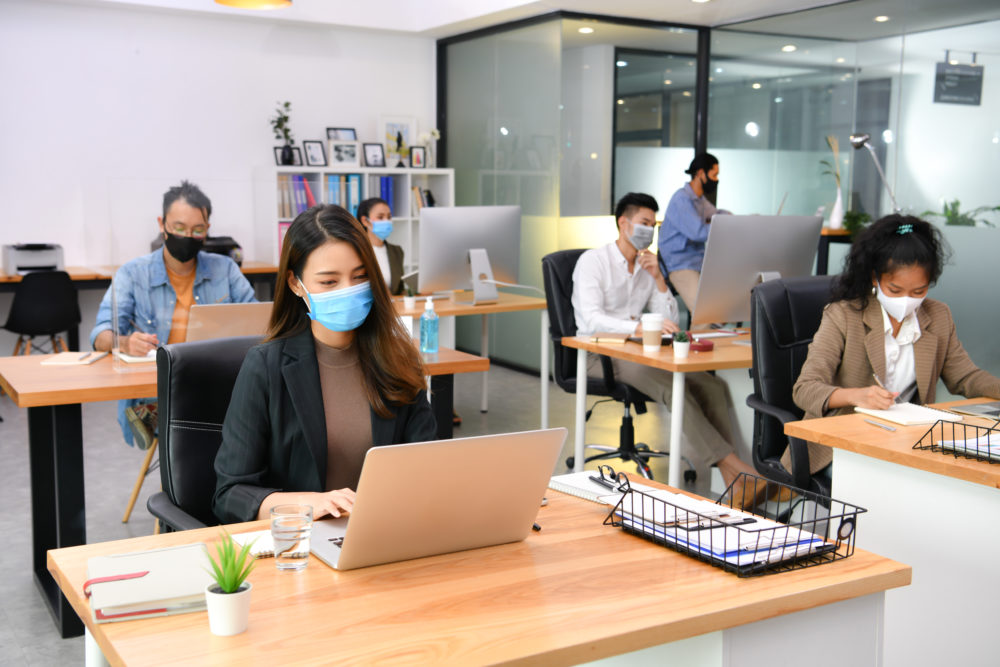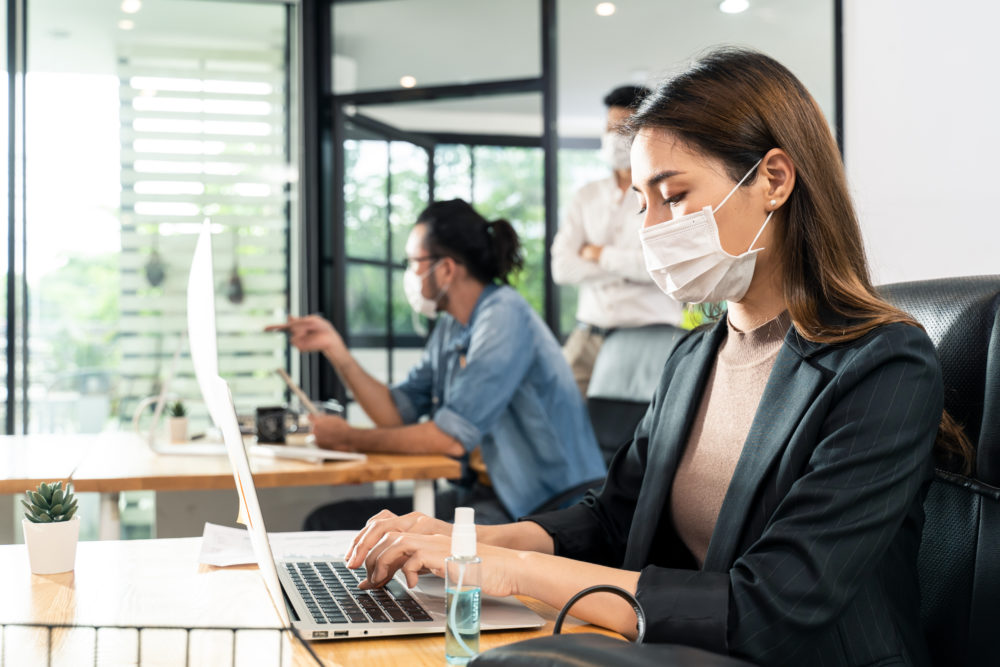Proactive organizations now have plans in place to create safe work environments that protect employees as they return to work. Diminishing the risk of exposure to COVID-19 in the workplace is the first step in order to assure employees that their health and safety is your top priority.
As you orchestrate and implement plans, keep these five myths about workplace safety in a post-COVID-world in mind:
Myth #1: Businesses that re-open should require all employees to return to the office immediately.
Inviting employees back to work must be done thoughtfully. Employers need to first evaluate the work environment and identify changes that will help enhance worker safety.
For example, some floor plans may need to be retrofitted with acrylic shields between each employee. Desks may need to be moved to increase spacing among employees.
New procedures will need to be implemented in common areas and conference rooms such as occupancy sensors and touch screens, and remote controls.
Many organizations are adopting a phased re-opening, which allows them to test new practices and make adjustments that enhance employee safety and confidence.
It’s important to keep in mind that some employees (those with disabilities or childcare and eldercare responsibilities) may not be able to return to the workplace immediately.
Organizations should review city, state, and federal guidelines and design plans based on meeting these requirements and recommendations.
Myth #2: If employees wear masks, in-person meetings and gatherings are safe.
Wrong. The Occupational Health and Safety Administration (OSHA) and the U.S. Centers for Disease Control and Prevention (CDC) agree that face coverings are not a substitute for social-distancing measures.
The CDC’s website has suggestions for businesses on other measures to consider as well such as:
- Staggering shifts
- Increasing physical space between workstations
- Using signs or tape to indicate where to stand to maintain a 6-foot distance
- Postponing meetings
- Limiting access to spaces where employees may congregate
Emphasize the need for social distancing at work and include measures that are appropriate for your employees in their particular workspaces. Communicate these requirements and COVID-related policies often!
Myth #3: Personal device security is equal to company device security.
It may appear obvious that personal device security doesn’t match that of company device security, but many organizations have enabled – even encouraged – employees to use their personal devices for company business without understanding the risk.
Implementing remote security on personal devices used for company business is complex and challenging. But as employees continue to work from home – and begin to return to the workplace – ensuring security remains a top priority.
In a normal work environment, IT implements and manages two-factor authentication, content filtering, identity and access management, encryption, auto backups, authentication and security monitoring to any personal device used for company business.
This must be applied to personal devices, too since they are currently, and will likely remain, used for company business.
Myth #4: Social distancing in conference rooms is adequate to avoid COVID-19
Many teams need the ability to collaborate and brainstorm to produce good outcomes. For these groups, in-office meeting spaces are essential.
Conference rooms, huddle rooms and common spaces where employees gather give people the ability to socialize, enjoy their colleagues and get work done. But simply applying social distancing requirements to these workplace spaces doesn’t cut it.
As employees return to work, they must understand new protocols when using conference rooms. Consider implementing the following to reduce the potential transmission of COVID-19:
Enforce room booking etiquette.
Use a meeting room booking tool so employees know which areas are available and best serve their needs in terms of resources and capacity.
Reserve only the space that is needed.
If a team meeting of 10 people is needed, for example, employees should reserve a room where three people maximum are present and the rest participate remotely. These hybrid conference room experiences allow larger meetings to stay safely distanced and encourage best use of spaces.
Eliminate the use of conference rooms as personal crash zones.
Employees should no longer be allowed to reserve a conference room to do uninterrupted work. Instead, consider installing ventilated, mobile workspaces that offer privacy when employees need it.
Update meeting rooms with touchless technologies.
When employees schedule their first collaborative meeting upon their return to work, what if they could walk into a conference room, start the meeting and share content from their personal devices? It’s possible right now. A few clicks and swipes on your personal device and now you’re sharing your presentation.
IT leaders can create virtually touchless meeting spaces by updating conference rooms with technology that instantly recognizes employees, automatically wakes up displays and connects with remote meeting participants via Microsoft Teams, Zoom, or a similar platform.
Virtually touchless meetings mean eliminating the use of shared touch panels and remotes, reducing the potential spread of COVID-19.
Myth #5: Customer visits to the workplace don’t pose a threat.
Managing those who visit the workplace has always been important to workplace safety (think about the check-in procedures your organization has in place to ensure those who enter the office truly belong there).
As organizations examine their return-to-work strategies, workplace leaders must take a critical look at how to best ensure the safety of both employees in the office and the visitors who enter the workspace to conduct business.
Before allowing office visits, update your visitor management policy. Make sure it addresses issues such as:
- When visitors are informed of your new COVID-19 office policies.
- Are visitors required to pre-register to ensure office occupancy levels are maintained?.
- Does the visitor check-in process still make sense?
- Does the visitor management system need an update?
- Does the check-in process gather the right information from each visitor?
- How are visitors screened? Are temperature checks required?
- Once checked in, how are visitors identified? A disposable photo ID badge, for example.
- How are employees notified when a visitor is checked in to see them?
- Are there new restricted areas that visitors aren’t allowed in and should office visits be conducted in a central area?
Consider new technologies that will track important data (thermal imaging, for example) and strive to dispose of outdated techniques, such as re-usable ID badge holders and shared sign-in sheets.











